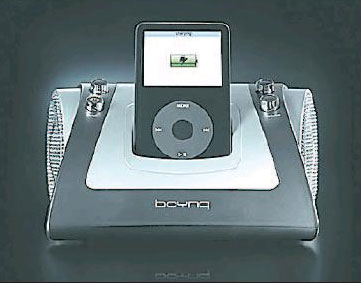Leslie Cauley
USA Today

A WiMax tower and base station on a downtown Chicago rooftop
Ultra-hip fashion designer Nanette Lepore, famous for her saucy minis and sky-high platform shoes, has added one more item to her “It” list this fall: a hot new wireless technology.
Her fashion house recently began using an advanced wireless technology called “WiMax” in two Manhattan offices. The service by Towerstream provides fast broadband and Internet phone calling for 110 users.
In fashion terms, the move to WiMax was, well, seamless.
“It’s completely transparent to the user,” says network manager Jose Cruz. “People don’t know they’re getting it.”
Around the globe, there is growing support for WiMax — short for Worldwide Interoperability for Microwave Access.
It can be used for “fixed” office solutions, a la Lepore, but what’s really building interest is its potential for high-speed data surfing on the go via wireless phones and other WiMax-enabled devices.
Unlike Wi-Fi wireless technology, which is limited to small hot spots such as Starbucks or the home, WiMax can cover several miles or more. Proponents — including some heavyweights such as Sprint and Motorola— say a network of WiMax towers could make the USA one huge hot spot.
The rush to embrace WiMax is being driven by advances in technology, a shifting competitive landscape and consumers’ ever-expanding appetite for broadband wherever they are.
Also adding impetus: The Federal Communications Commission is urging companies to deploy WiMax quickly to expand mobile broadband options for consumers.
WiMax technology was developed for mobile data transmission, but it’s also ideal for Internet phone service. That makes WiMax exciting as a consumer product — and threatening to traditional wireless carriers, says Clearwire CEO Ben Wolff. The company, backed by wireless pioneer Craig McCaw, is working with Sprint to build a national mobile WiMax network.
“It will do for the U.S. consumer what we did for the U.S. consumer 20 years ago when we came out with cellular,” Wolff says. By enabling people to surf the Internet anytime, anywhere, on any device, it “will be as game-changing as when you no longer required people to be tethered to a 6-foot cord to make a phone call.”
Unlike Wi-Fi, which is unlicensed, more-powerful WiMax uses airwaves that require a government license — the same as cellphone service.
Not surprisingly, carriers that have WiMax licenses, such as Clearwire, are bullish on its future. Those that don’t, including companies that want to offer mobile broadband via cellphone networks, are quick to dismiss it as a fad.
WiMax is a workhorse, so it can support lots of high-bandwidth customers with ease. That translates into fast broadband at cheaper prices. Cruz says his Internet and phone bills are 50% to 75% cheaper than what he used to pay Verizon.
As for performance, Cruz is paying Towerstream for a 3-megabit connection in both directions, but he says speeds have hit 10 megabits. He hopes in time to adopt mobile WiMax for Nanette Lepore’s international sales force. “Our idea is to bring in the best technology for our time to provide us with the best bang for the buck.”
On the move
While “fixed” WiMax has proved useful, mobile WiMax is relatively new — and controversial. Critics say it offers few advantages over conventional wireless broadband options.
The biggest WiMax proponent in the USA is Sprint, the No. 3 wireless carrier. In addition to Clearwire, it’s working with a stable of wireless allies — Motorola, Samsung, Nortel and Intel among them — to push mobile WiMax globally.
Atish Gude, Sprint’s senior vice president of mobile broadband, says the growing popularity of Wi-Fi only underscores Sprint’s belief that broadband users want to take the Internet with them on the road. Mobile WiMax won’t disappoint, he promises.
“It will really be like the broadband that we experience today” with DSL or cable modems, Gude says. “It will be the real Internet.”
Motorola CEO Ed Zander predicts WiMax will take off like a shot when WiMax-enabled devices powered by Intel chips — laptops, handhelds, smart-phones and more — hit the market next year.
“WiMax could be even bigger and more dramatic than the original Internet,” he says, adding: “We’re doubling down and betting the farm” on WiMax.
Smiling users?
Consumers could be the big winners, says Moe Tanabian, a principal at IBB Consulting in Princeton, N.J. Because WiMax is efficient, he thinks retail prices for consumers will be cheap compared with today’s cell-based wireless broadband.
Over time, he says, WiMax will deliver Internet speeds up to 100 megabits per second on the downlink path and 10 megabits on the uplink. “That happens around 2012.”
That remains conjecture, however. To prove their case, WiMax supporters need a real network with real customers.
Cut to Sprint and Clearwire. Their planned nationwide network has Clearwire focusing on smaller markets and Sprint tackling big cities. To complete the job, they’ll have to install mobile WiMax gear at more than 60,000 cellphone sites across the USA.
Sprint has committed $5 billion, but allows that the final tab will be a lot more. Its first markets — Chicago and Washington, D.C. — are expected to go live in the spring.
Gude says consumers are in for a few nice surprises — such as no service contracts. Customers also will be allowed to use any WiMax device or software. “We’ll take anybody.” That’s a big departure from typical cellphone businesses, which put strict limitations on devices and software.
Once mobile WiMax takes off, Sprint thinks cellphone carriers will be forced to change their ways. “The pressure will come from customers,” Gude says.
Other viewpoints
Not surprisingly, wireless companies that don’t own oodles of WiMax spectrum, as Sprint does, have a different view.
AT&T, the largest U.S. cellphone company, favors cell-based HSPA (High-Speed Packet Access) technology for offering mobile broadband.
Kris Rinne, an AT&T senior vice president, acknowledges that her company has few WiMax licenses, but says that’s not the issue. “We view WiMax as very suitable for fixed” locations, she says. For mobile wireless, however, “HSPA is the right choice.”
For Rinne, it all comes down to the numbers. While mobile WiMax is in development, HSPA is based on a wireless standard called GSM that is already used by 85% of the world’s mobile phone population. In addition, “more than 180 operators worldwide already use HSPA.”
Her point: WiMax as a standard will have a hard time getting global traction. “Lots of times, a technology has some great aspects, but it gets overhyped in terms of how it will develop,” Rinne says.
HSPA supporter Hakan Eriksson, chief technology officer of Swedish equipment giant Ericsson, agrees. “WiMax technology is not offering anything in terms of performance that HSPA is not already offering.”
To be sure, mobile WiMax is in the early stages of development, but IBB Consulting says it’s poised for fast growth. By 2012, IBB predicts, it will have 45 million subscribers in North America.
Even so, it would still have a long way to go to catch HSPA, which already claims more than 300 million users worldwide.
While HSPA can leverage off its global audience, “WiMax has to start from scratch,” Eriksson says.
Confident supporters
Motorola CEO Zander says he expects such criticism. “IBM said the same thing about mainframes” never being overtaken by PCs, he chides.
“Incumbents,” he adds, letting the word hang in the air for a moment, “you know how they are.”
As any technology buff knows, mainframe computers have survived for some uses, but PCs now rule the world. Therein, Zander says, lies a Golden Rule of business: “Don’t bet against technology.”
“If there is something that is compelling to people, it will happen,” says Zander, who spent years in the trenches of Silicon Valley before jumping to Motorola. “Incumbents might wind up doing it, or new entrants might wind up doing it, but it will happen.”
Peter MacKinnon, general manager of WiMax for Nortel, seconds that notion. While HSPA is strong, he says, history has shown that clever innovation can — and often does — trump the status quo. Witness the death of eight-track tapes, VCRs and pay phones.
“The WiMax industry is here; it’s going to happen,” says MacKinnon. “We need to think about what we’re doing with our nice, comfortable (wireless) world we live in, because it’s about to be shaken.”








